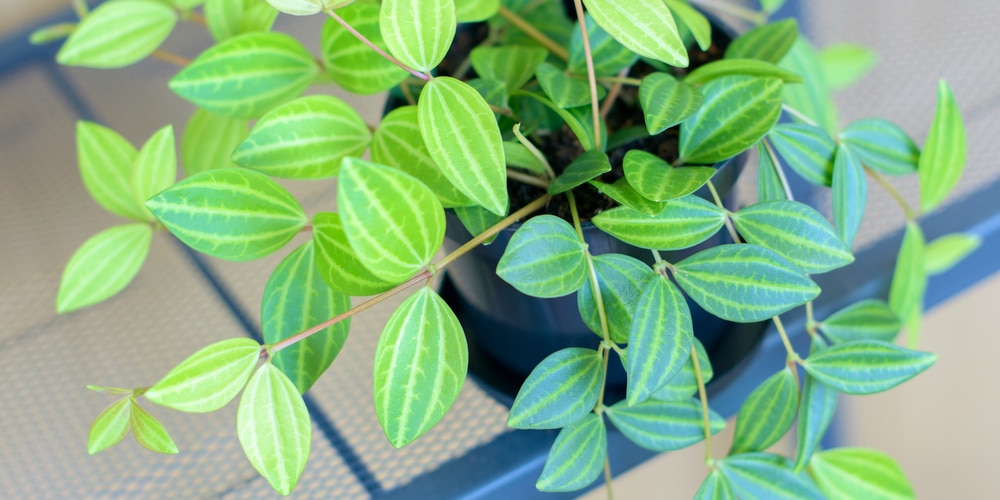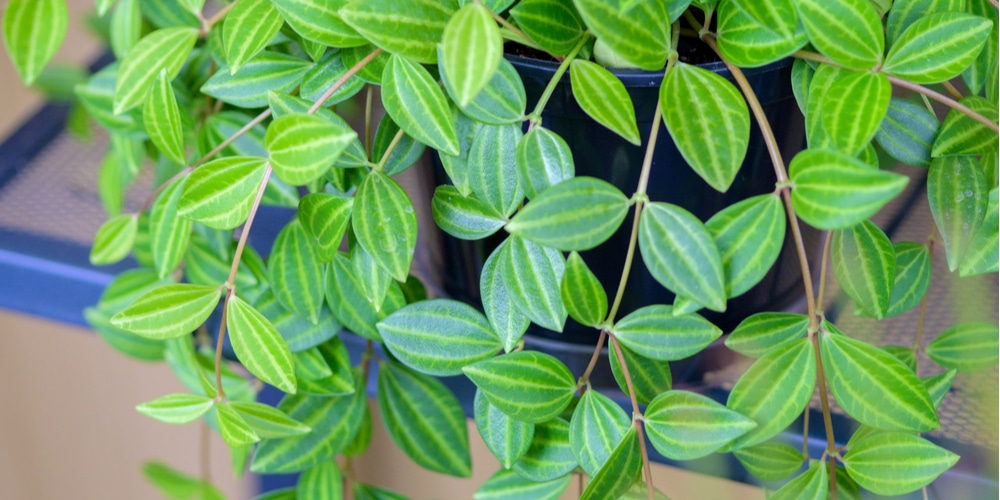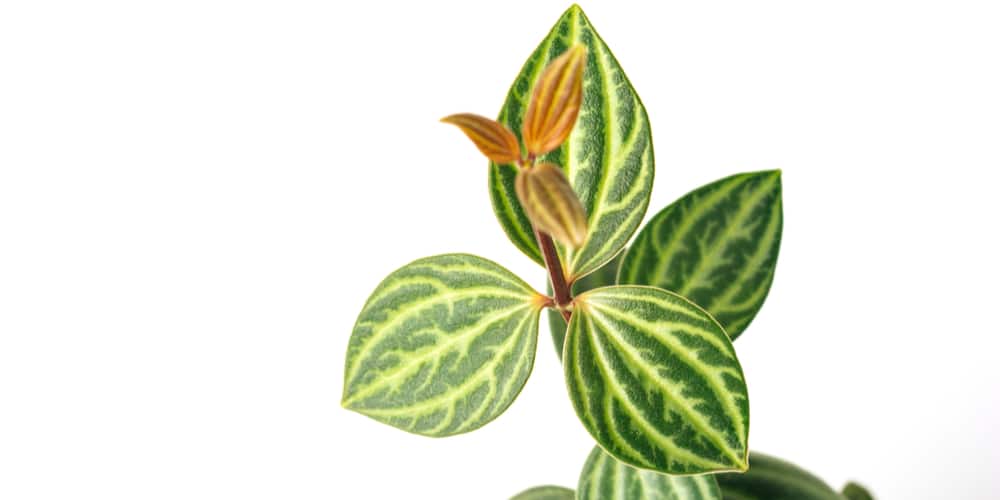Peperomia angulata is a lovely species with leaves that look like ripe watermelon skin. Every leaf has light green variegation on the upper leaf surface. The lines run perpendicularly to the stem. And the best part is that this plant needs only a couple of hours of west-facing sun to grow fast and make new foliage.
Botanical Name: Peperomia angulata Kunth, Peperomia quadrangularis
Common Name: Beetle peperomia
Plant Type: Perennial
Flower Color: White
Size When Mature: 7-12 inches (height), ~18 inches (width)
Bloom Time: Summer
Sun Requirements: Partial Sun
USDA Hardiness Zones: 9b-11a
Soil PH Range: 4.0-6.5
Soil Type: Acidic, well-draining
Water Needs: Low
Native Area: Amazon basin, South America
What you Need to Know About The Peperomia Angulata
As its names suggest, Peperomia angulata has angular leaves that look like a beetle’s elytra. The leaves creep down on the trellis. But you can prune your peperomia and give its foliage a bushy, compact look that makes it the ideal tabletop plant.
You can keep your Beetle peperomia wherever you want in the house because this species is low maintenance and non-toxic. Mainly, this ornamental plant needs an aerated soil mix to thrive.
And if you do not overwater it, the plant will last for many years, making it a good peperomia variety for a new houseplant lover.
Like other peperomias, this species also produce tiny white flowers. The flower spikes appear in summer in nature.
But the plant can bloom between April and December indoors. The flowers of a peperomia quadrangularis usually last a couple of months but have no remarkable scent.
How to Care for A Beetle Peperomia
Here’s everything you need to know about growing and caring for a thriving Peperomia angulata.
Light
The typical Peperomia angulata Kunth prefers medium to bright indirect light. In general, direct sun exposure causes the leaves to burn out the beautiful variegation to fade away.
Artificial lighting is enough to keep your Beetle peperomia healthy. But if you want to provide a couple of hours of late afternoon and sunset light to promote growth, you can place your ornamental plant in a west-facing window. Rotate the plant every week for a bushier appearance.
If you keep your plant in a low light condition, move it to a brighter spot. This species must receive at least five to six hours of indirect light every day.
Water and Soil Needs
The best Peperomia angulata soil is acidic, with a soil pH between 4.0 and 6.5. And above all, well-draining. If you want to make your own soil mix for propagation, you can add perlite and coarse sand to an all-purpose potting soil to improve aeration and drainage.
Then, add some orchid bark to lower the soil pH. Keep a 1:1:1:1 ratio for the best results. On a side note, the Cornell Epiphytic Mix also works well.
This species has delicate, shallow roots. So, it will not tolerate compacted soil. What is more, make sure the pot has big drainage holes to prevent water stagnation, which can cause root rot.
Bottom watering works best for most peperomias because the soil soaks enough water without causing aeration problems. This is especially true for this variety.
So, if you water this plant from the top, stick a finger in the potting mix before pouring water—make sure the first inch of soil is absolutely dry.
Temperature Requirements
The best planting zones for growing a Beetle peperomia outdoor in the spring and summer are USDA zones 9 to 11.
Peperomia angulata is native to South America. So, it needs a humid, warm climate and constant temperatures between 65-75F.
In their natural habitat, they bathe in humidity but do not deal with moist soil. This fact is key to understanding why your peperomia can last more than a week without a drink in the open but does not thrive in your enclosed room with less than 60% humidity.
Fertilizer
If you provide a loose, neat potting mix, you do not have to fertilize your Peperomia angulata. In detail, the plant will thrive for many years with no need for extra nutrients. But if you spot any nutrient deficiency, a weak dilution of a liquid 10-10-10 fertilizer will do.
In any case, there is no need to fertilize the plant during fall and winter. When the temperatures drop below 50F, this plant stops growing. So, your fertilizer would end up causing the soil to become toxic for the plant when the warm seasons come back.
Common Diseases
Including crown rot, the most destructive diseases are those caused by fungi.
If you notice any colored spot on the dark green leaves, isolate your Peperomia angulata immediately. Above all, cut and destroy the infected leaves.
Fungal infections usually develop in the soil. But some fungi can affect the foliage and then spread to other houseplants. For the same reason, it is better to keep your Beetle peperomia away from any potentially infected plant.
Peperomia Angulata Propagation
The best time to propagate your Peperomia angulata is in late spring and early summer when the plant is already producing new growth.
- Prepare a 50/50 mix of sphagnum moss and sand for the cuttings to develop new roots. As an option, water propagation can work too. But if you use tap water, let the water sit for 24 hours to let chlorine and other chemicals dissipate.
- Touch the propagating mix to make sure it is slightly moist but not damp. If dry, spray some water and knead the potting medium by hand. Otherwise, remove the excess water.
- Select a long stem without a flower spike.
- Make a cutting that contains three levels—five or six leaves in total. More importantly, cut right above the last node. Use a sterilized pruning shear or pair of scissors.
- Place the cutting inside the potting mix. Above all, do not let the soil bury or cover the leaves because that could promote fungal diseases. If the stem is too short, remove the bottom leaves until you can push down the cutting inside the medium effortlessly.
- Arrange the cutting’s leaves on top of the potting medium and do not let them droop outside the container—if you do, they will shrivel up and die.
If your cuttings die, check the humidity level and make sure it is above 60%. Alternatively, try spraying the cutting once with water. Or use some plastic wrap to seal the container—change the air every day or two, though.
You may also like: Peperomia Rana Verde


